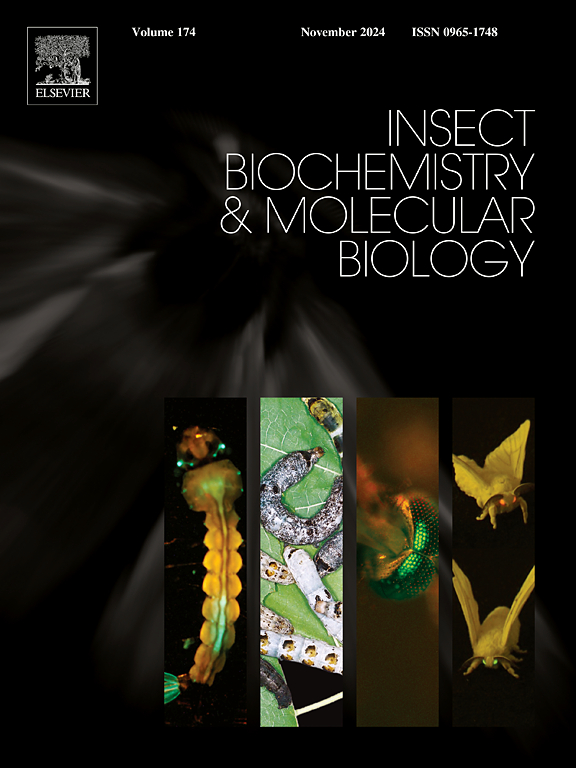Solvent-, enzyme-, and structural-dependence of phenyl-substituted methyl carbamate inhibition of acetylcholinesterase
IF 3.7
2区 农林科学
Q2 BIOCHEMISTRY & MOLECULAR BIOLOGY
引用次数: 0
Abstract
This study explored how dilution protocols, enzymes, and solvents affected the performance of 2- and 3-phenyl substituted methylcarbamates with varying selectivity for Anopheles gambiae acetylcholinesterase (AgAChE). Protocol A was 100-fold suspension in buffer of a 0.1 M DMSO stock solution, followed by serial buffer dilutions to give declining DMSO in parallel with the inhibitor. Protocol B was identical to A except that the initial stock concentration was 0.01 M. Protocol C entailed DMSO serial dilutions of a 0.1 M DMSO stock solution, followed by suspension of each into buffer giving 0.1 % (v/v) DMSO in all incubates. An. gambiae enzymes from insect homogenates or a recombinant clone generally showed a progressive increase in Hill slope from 0.5 to 1 via protocols A-C, along with increased IC50 values, with the 3-tert-butyl analog (1) epitomizing these effects. In contrast, propoxur displayed no consistent change in inhibition potency of any AChE, regardless of DMSO dilution procedure. DMSO at constant 35 μM or 0.000273 % had a midpoint effect on compound 1 inhibition and displayed competitive inhibition. Time course incubations (10–60 min) over a broad concentration range (10−12 - 10−5 M) of 1 revealed saturable inhibition of high and low potency, with the high potency effect more sensitive to incubation time. In contrast, there was little change of inhibition potency or Hill slope for compound 1 with human AChE, or the AChEs of Drosophila melanogaster and Musca domestica under any DMSO dilution protocol. Moreover, when the dilution protocols were repeated using ethanol as a solvent, little change of inhibition potency or Hill slope was observed with any compound, enzyme, or dilution scheme. These results contradicted the expectation that higher solvent concentration would yield better solubility and more rapid and potent effects of these lipophilic insecticides. Molecular modeling suggests DMSO may be competing with carbamate binding to AgAChE or by stabilizing an allosteric subpocket within AgAChE.

苯基取代氨基甲酸甲酯抑制乙酰胆碱酯酶的溶剂、酶和结构依赖性
本研究探讨了稀释方案、酶和溶剂如何影响2-和3-苯基取代氨基甲酸甲酯对冈比亚按蚊乙酰胆碱酯酶(AgAChE)不同选择性的性能。方案A是在0.1 M DMSO原液的缓冲液中100倍悬浮,然后连续稀释缓冲液,使DMSO与抑制剂同时下降。方案B与A相同,除了初始储存浓度为0.01 M。方案C需要DMSO连续稀释0.1 M DMSO原液,然后将每种DMSO悬浮到缓冲液中,在所有孵育中给予0.1% (v/v) DMSO。一个。通过a - c方案,从昆虫匀浆或重组克隆中获得的冈比亚酶通常显示Hill slope从0.5逐渐增加到1,IC50值也随之增加,3-叔丁基类似物(1)体现了这些效应。相比之下,无论采用何种DMSO稀释方法,残杀威对AChE的抑制效力都没有一致的变化。35 μM或0.000273%的DMSO对化合物1的抑制作用为中点效应,表现为竞争性抑制。在较宽的浓度范围(10−12 - 10−5 M)内孵育(10 - 60 min)显示出高效和低效的饱和抑制,其中高效效应对孵育时间更敏感。而化合物1对人乙酰胆碱酯(AChE)、黑腹果蝇(Drosophila melanogaster)和家蝇(Musca domestica)的乙酰胆碱酯(AChE)的抑制效价和Hill slope在任何DMSO稀释方案下均无明显变化。此外,当使用乙醇作为溶剂重复稀释方案时,任何化合物,酶或稀释方案的抑制效力或Hill斜率几乎没有变化。这些结果与高溶剂浓度会产生更好的溶解度和更快更有效的亲脂性杀虫剂的预期相矛盾。分子模型表明DMSO可能与氨基甲酸酯结合AgAChE或稳定AgAChE内的变构子袋竞争。
本文章由计算机程序翻译,如有差异,请以英文原文为准。
求助全文
约1分钟内获得全文
求助全文
来源期刊
CiteScore
7.40
自引率
5.30%
发文量
105
审稿时长
40 days
期刊介绍:
This international journal publishes original contributions and mini-reviews in the fields of insect biochemistry and insect molecular biology. Main areas of interest are neurochemistry, hormone and pheromone biochemistry, enzymes and metabolism, hormone action and gene regulation, gene characterization and structure, pharmacology, immunology and cell and tissue culture. Papers on the biochemistry and molecular biology of other groups of arthropods are published if of general interest to the readership. Technique papers will be considered for publication if they significantly advance the field of insect biochemistry and molecular biology in the opinion of the Editors and Editorial Board.

 求助内容:
求助内容: 应助结果提醒方式:
应助结果提醒方式:


